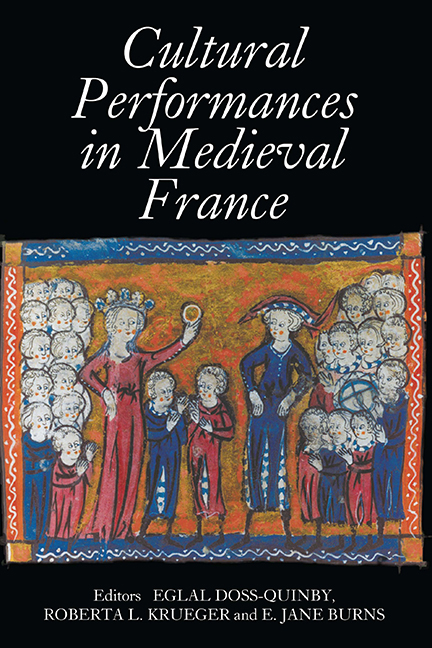Book contents
- Frontmatter
- Contents
- List of Illustrations
- Contributors
- Introduction
- Nancy Freeman Regalado, Curriculum Vitae
- PART I POETIC AND MUSICAL PERFORMANCES
- PART II PERFORMING SEXUAL AND SOCIAL IDENTITIES
- Intimate Performance: An Ivory Writing Tablet Cover at The Cloisters
- A Cultural Performance in Silk: Sebelinne's aumousniere in the Dit de l'Empereur Constant
- Acting Like a Man: Performing Gender in Tristan de Nanteuil
- Amorous Performances: The Aventure de l'espee vermeille in Perceforest
- Historicizing Performance: The Case of the Jeu de Robin et Marion
- The Protean Performer: Defining Minstrel Identity in Tristan Narratives
- PART III DEVOTIONAL PRACTICE AND TEXTUAL PERFORMANCE
- PART IV PERSUASIVE PERFORMANCES
- PART V RE–ENACTMENTS AND LEGACIES
- Tabula Gratulatoria
- Tabula Gratulatoria
Amorous Performances: The Aventure de l'espee vermeille in Perceforest
from PART II - PERFORMING SEXUAL AND SOCIAL IDENTITIES
Published online by Cambridge University Press: 24 October 2017
- Frontmatter
- Contents
- List of Illustrations
- Contributors
- Introduction
- Nancy Freeman Regalado, Curriculum Vitae
- PART I POETIC AND MUSICAL PERFORMANCES
- PART II PERFORMING SEXUAL AND SOCIAL IDENTITIES
- Intimate Performance: An Ivory Writing Tablet Cover at The Cloisters
- A Cultural Performance in Silk: Sebelinne's aumousniere in the Dit de l'Empereur Constant
- Acting Like a Man: Performing Gender in Tristan de Nanteuil
- Amorous Performances: The Aventure de l'espee vermeille in Perceforest
- Historicizing Performance: The Case of the Jeu de Robin et Marion
- The Protean Performer: Defining Minstrel Identity in Tristan Narratives
- PART III DEVOTIONAL PRACTICE AND TEXTUAL PERFORMANCE
- PART IV PERSUASIVE PERFORMANCES
- PART V RE–ENACTMENTS AND LEGACIES
- Tabula Gratulatoria
- Tabula Gratulatoria
Summary
The vast fourteenth-century prose Roman de Perceforest, a fictional chronicle of pre-Arthurian Britain under Greek rule, offers a fascinating exposition of courtly ideologies. In this essay I will examine a single episode, that of the Aventure de l'espee vermeille, which is played out in the course of Book V. In this adventure, young knights are offered an easy sexual encounter with a beautiful young maiden, and given to believe that it is only through sexual “performance” that they can prove their manhood. As the adventure progresses, however, it becomes increasingly clear that this kind of sexual adventuring is actually antithetical to the chivalric ideals of Perceforest's courtly society. Gallafur, the only knight who refuses sexual contact, is the one who succeeds in staging the noblest form of chivalric masculinity, proving himself worthy of marrying the princess Alexandre and founding an illustrious lineage. Spectators, in turn, can be judged according to their reading of the knights’ performance of the adventure: those with more limited vision perceive Gallafur's reticence as a sign of impotence and effeminacy, while Alexandre herself sees him as proving his fidelity to a noble love. In all, the adventure with its many participants and onlookers becomes a complex staging ground for competing ideals of gender and sexuality.
The Aventure de l'espee vermeille is devised by four maidens, identified only as “filles de l'une des seurs de Morgane la Faee” (daughters of a sister of Morgan La Fay; V, 4v). Through their powers of divination, the sisters learn that the greatest of all British kings – the prophecy refers of course to Arthur – will be descended from the late Gadifer, a Greek knight crowned king of Scotland by Alexander the Great during the latter's sojourn in Britain. Determined to do whatever they can to inscribe themselves into this Arthurian lineage, the maidens devise a rose-colored sword and display it in the forest, casting a spell that will prevent it from being taken up by any knight unless he is descended from Gadifer. The “publicity” surrounding the adventure states only that a knight who succeeds in lifting the sword must then carry it through the forest; if it loses its color, he has failed, and must relinquish the sword.
- Type
- Chapter
- Information
- Cultural Performances in Medieval FranceEssays in Honor of Nancy Freeman Regalado, pp. 91 - 98Publisher: Boydell & BrewerPrint publication year: 2007



